Charles E W Bean, Diaries, AWM38 3DRL 606/243A/1 - 1916 - 1934 - Part 12
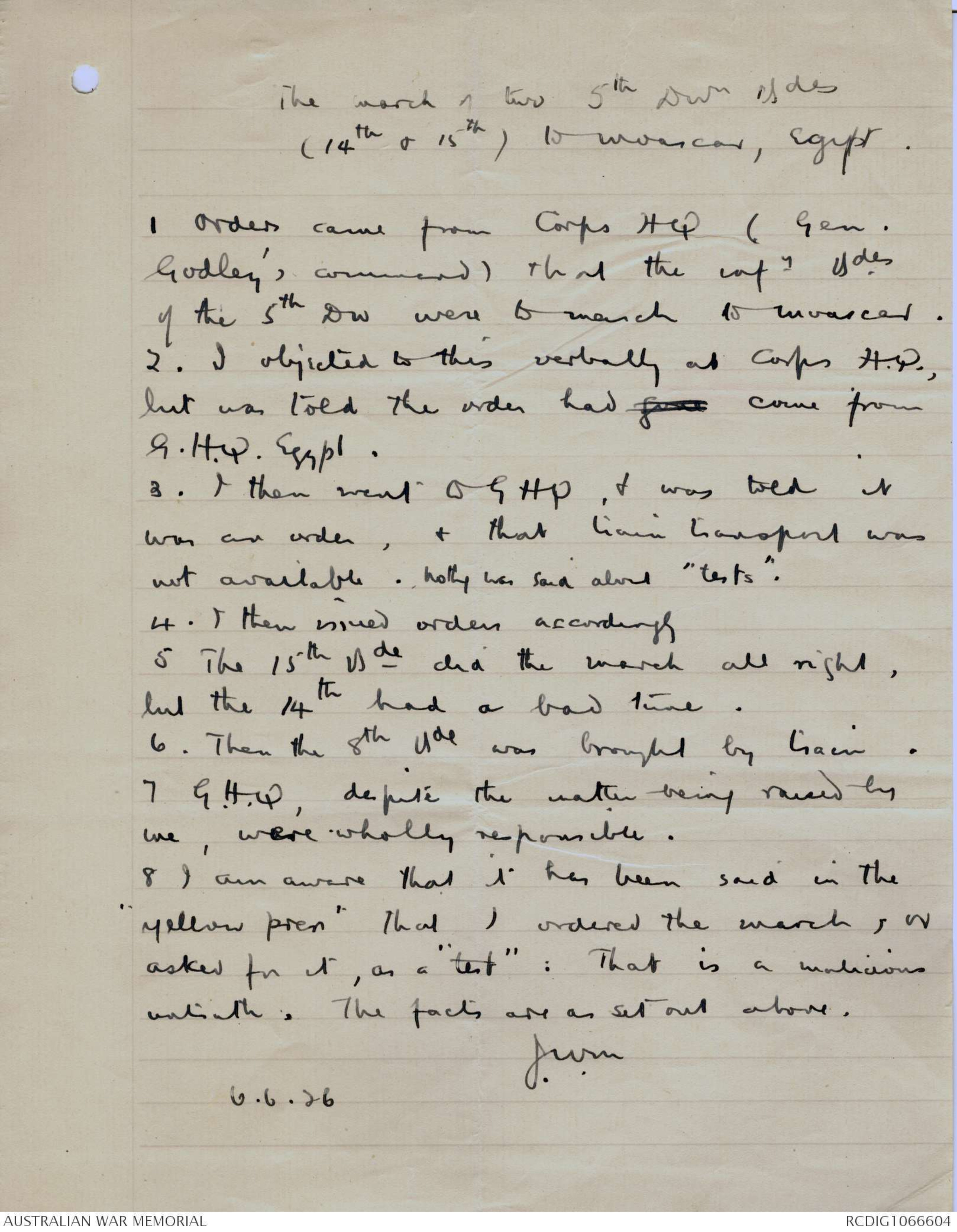
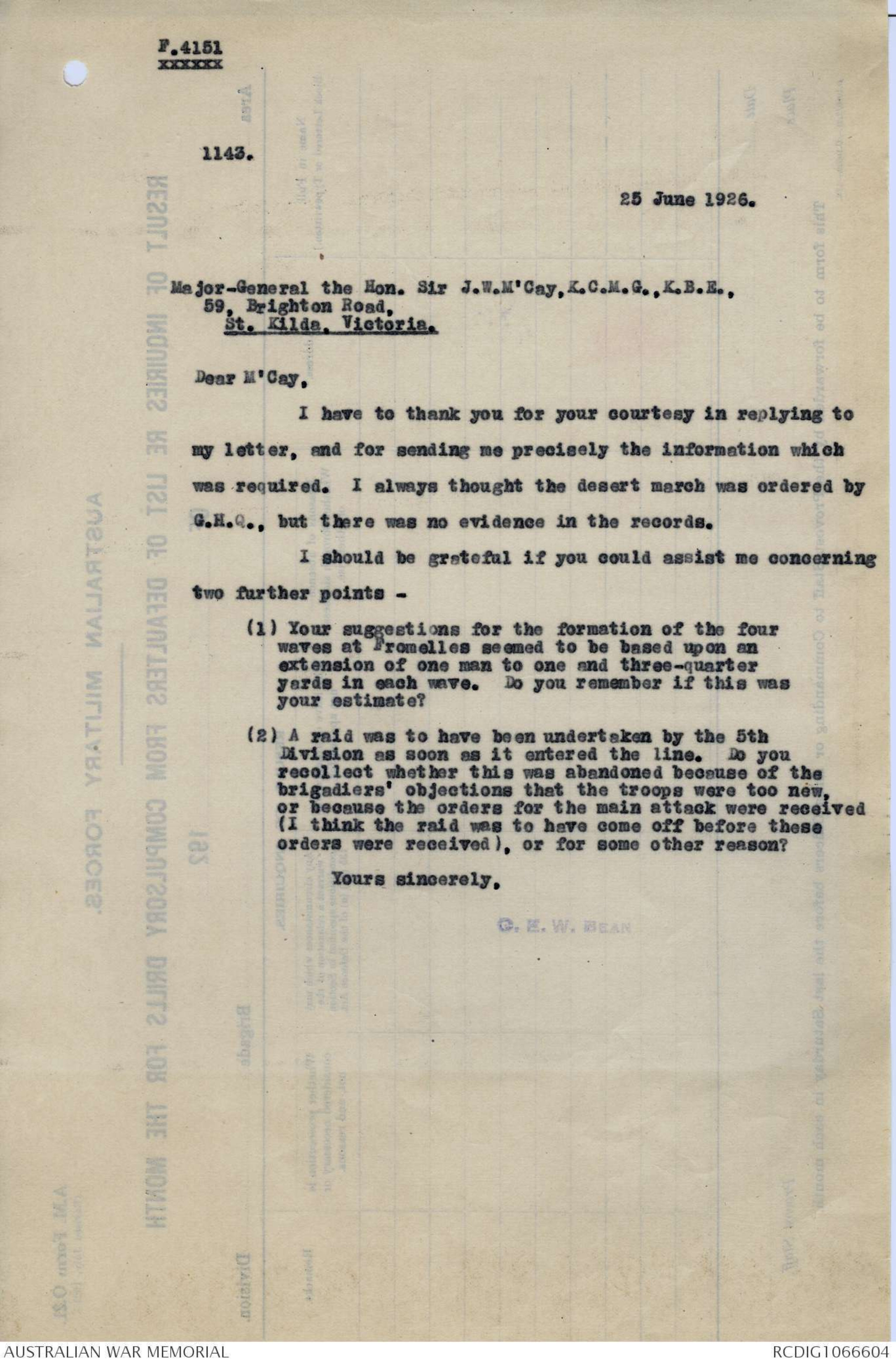
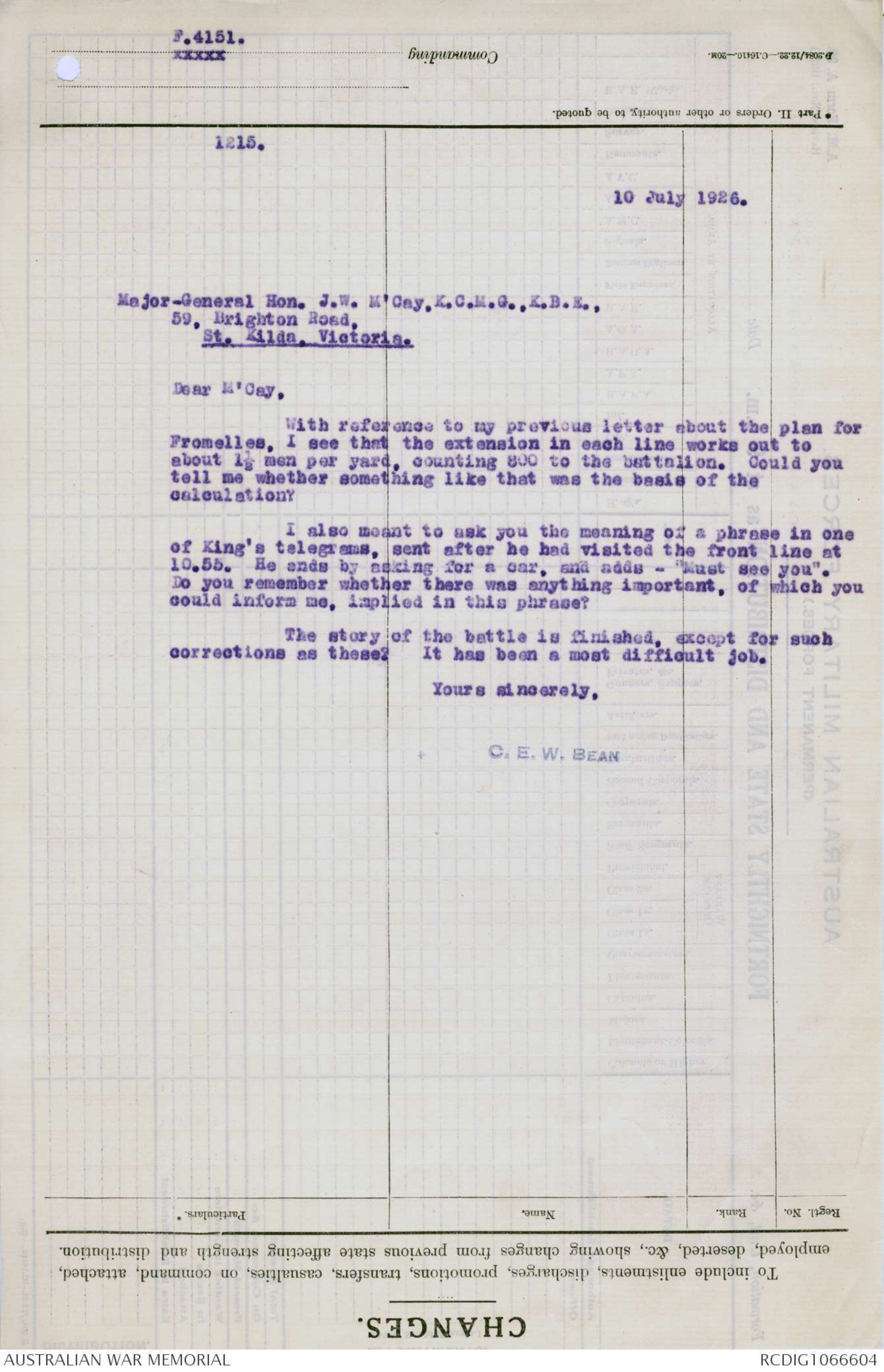
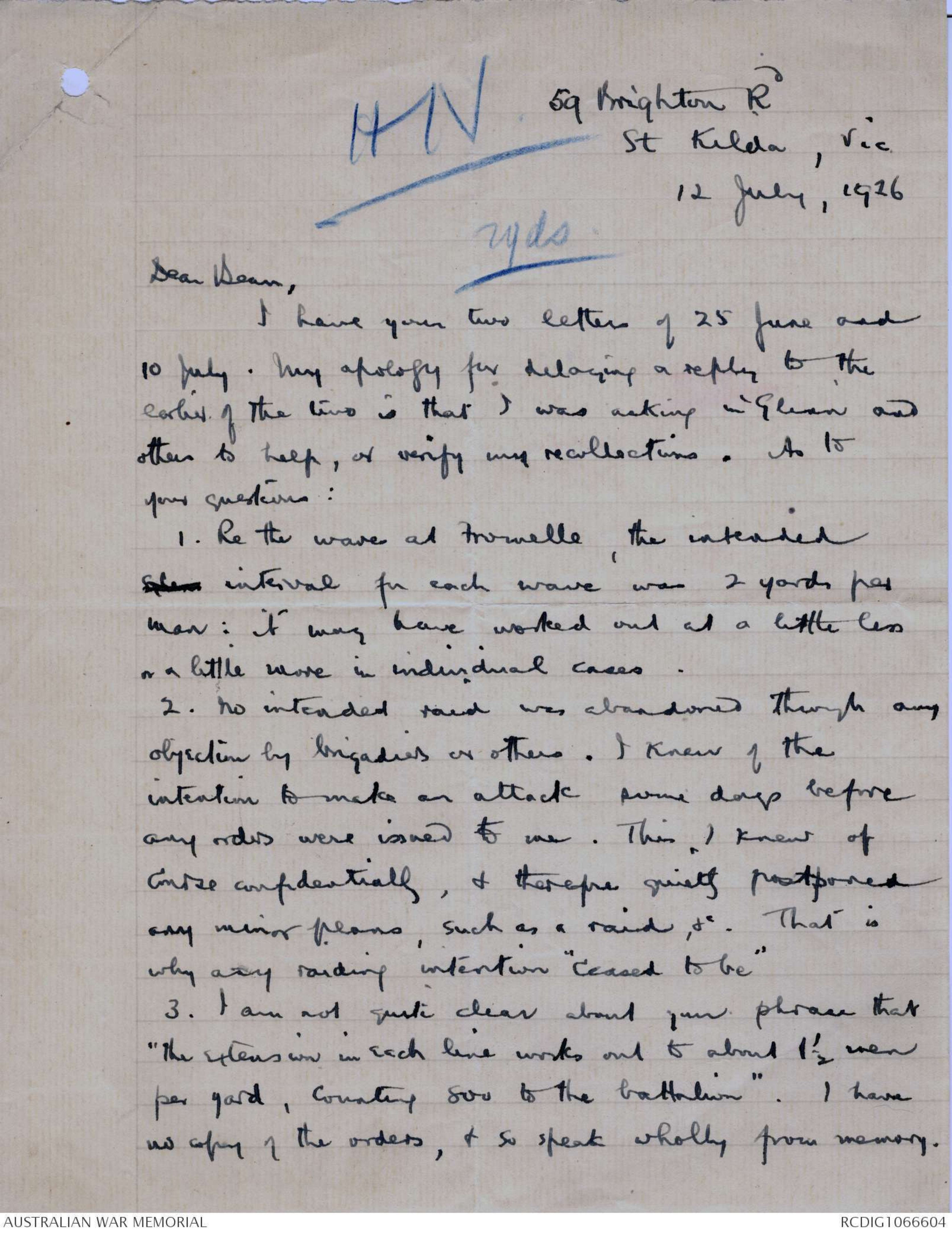
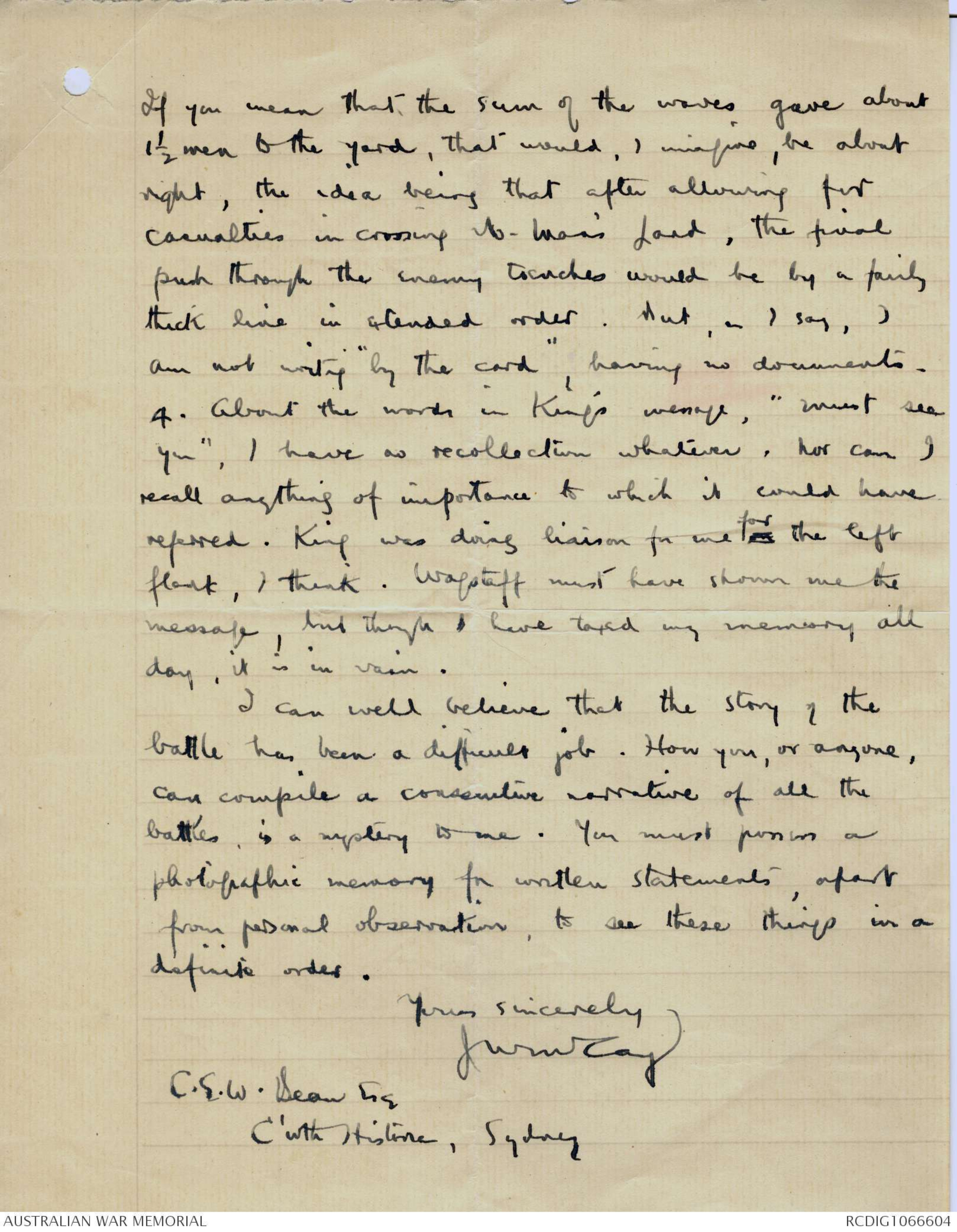
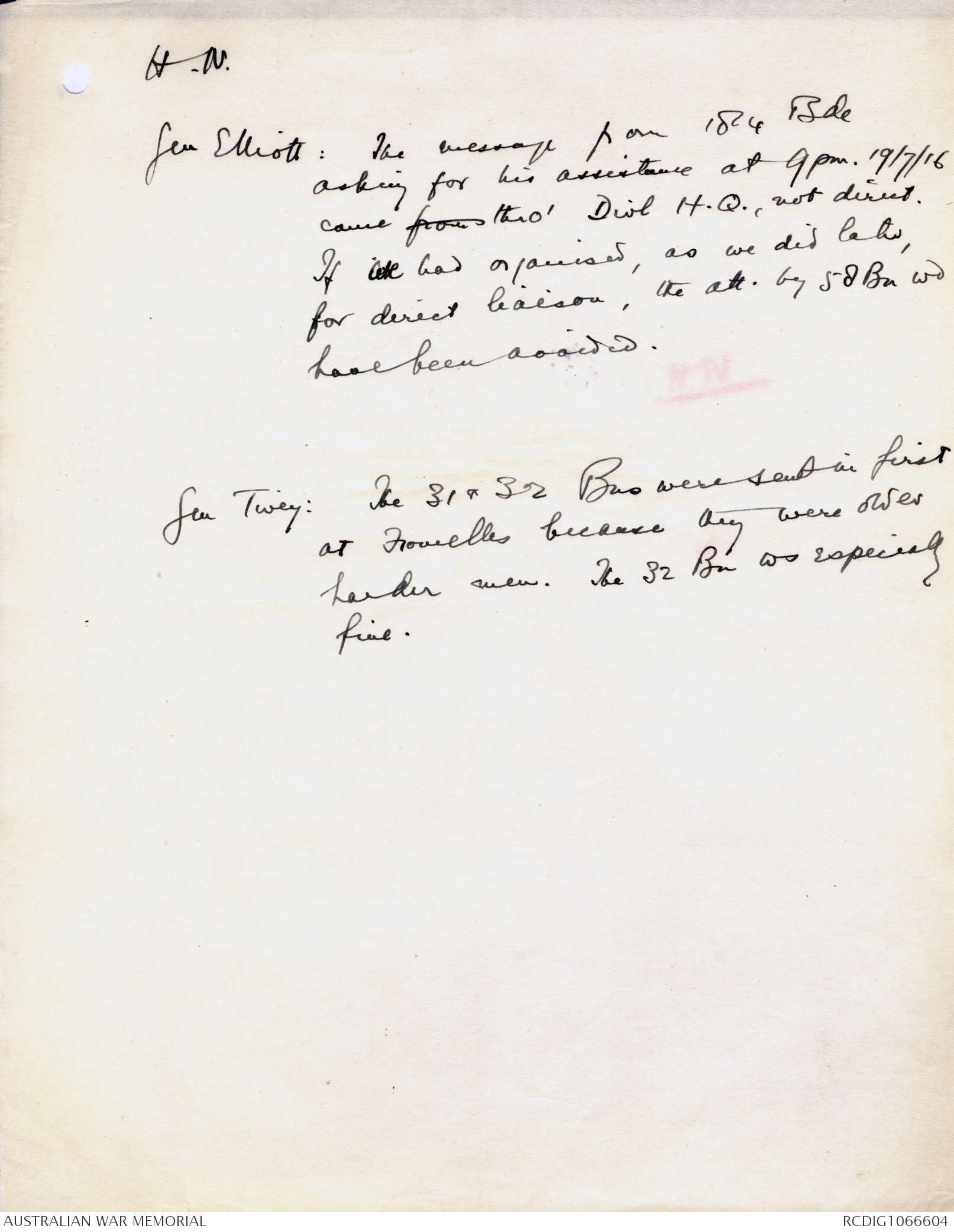
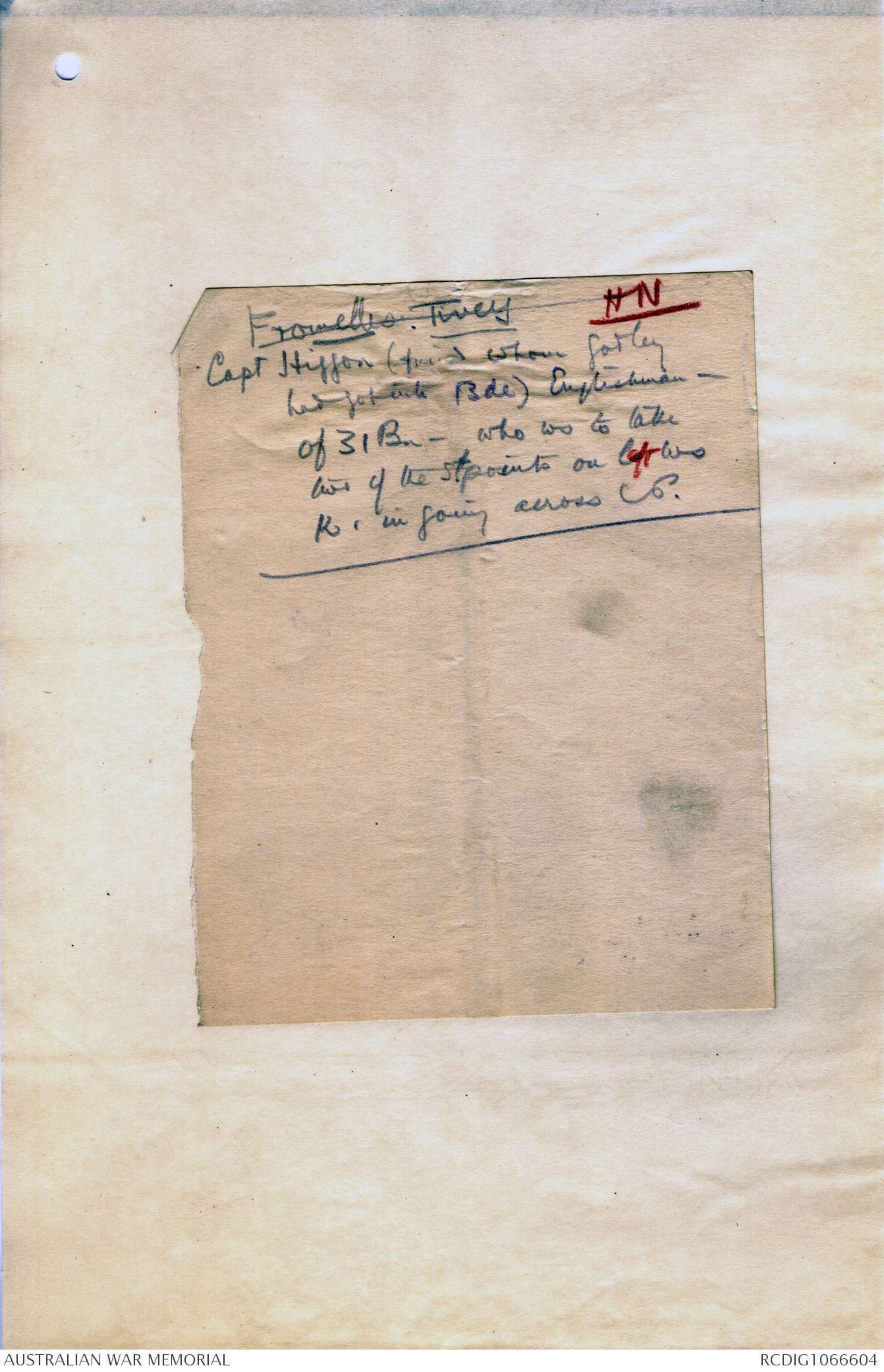

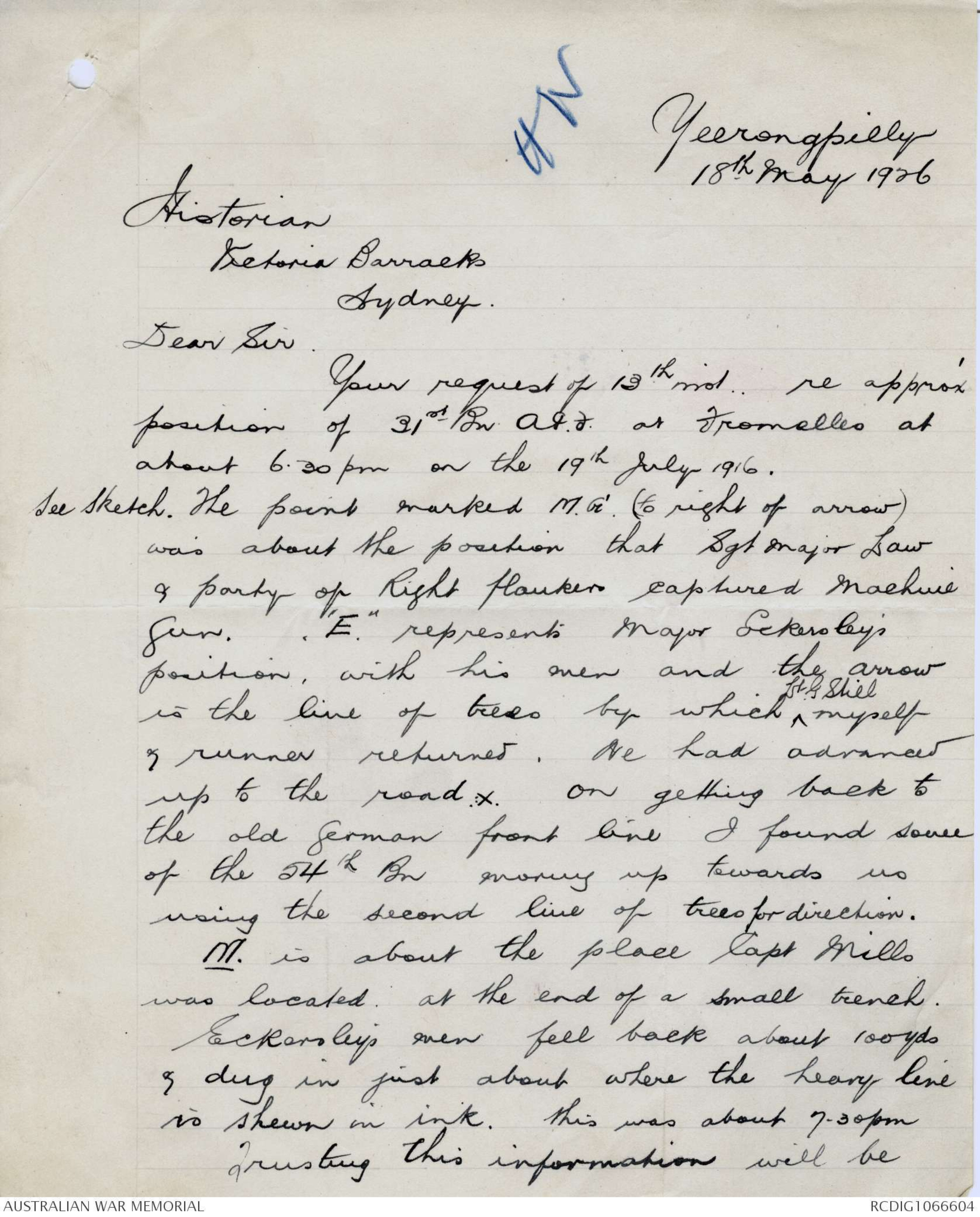
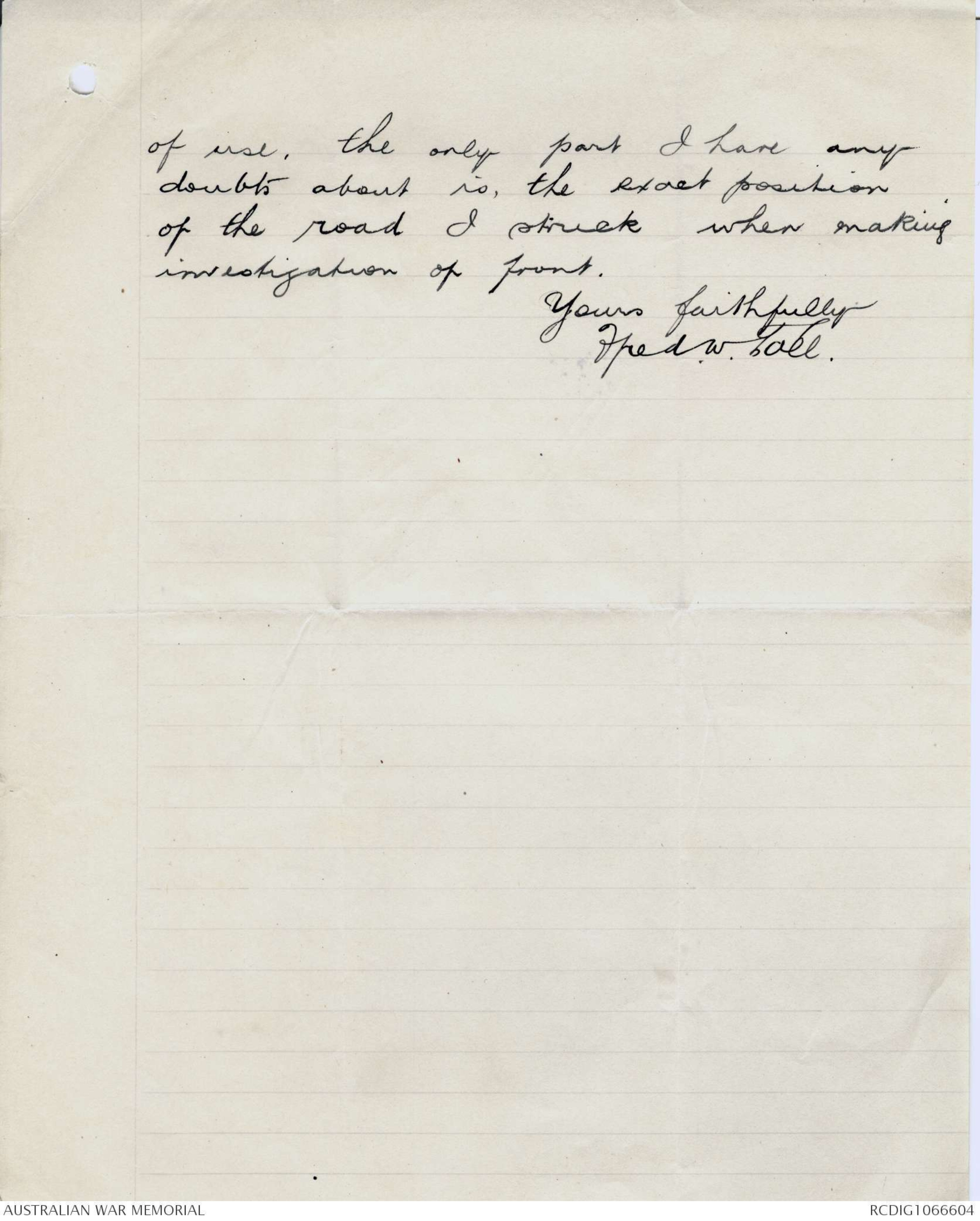
The march of two 5th Divn Bdes
(14th & 15th) to Moascar, Egypt.
1. Orders came from Corps HQ (Gen.
Godley's command) that the infy Bdes
of the 5th Div were to March to Moascar.
2. I objected to this verbally at Corps H.Q.,
but was told the order had gxxx come from
G.H.Q. Egypt.
3. I then went to GHQ, & was told it
was an order, & that train transport was
not available. Nothing was said about “tests”.
4. I then issued orders accordingly
5 The 15th Bde did the march all night,
but the 14th had a bad time.
6. Then the 8th Bde was brought by train.
7 G.H.Q, despite the matter being raised by
me, were wholly responsible.
8 I am aware that it has been said in the
“yellow press” that I ordered the march, or
asked for it, as a “test”: That is a malicious
untruth. The facts are as set out above.
J.W.M
6.6.26
F.4151
xxxxxx
1143.
25 June 1926.
Major-General the Hon. Sir J.W. M'Cay, K.C.M.G., K.B.E.,
59, Brighton Road,
St. Kilda. Victoria.
Dear McCay,
I have to thank you for your courtesy in replying to
my letter, and for sending me precisely the information which
was required. I always thought the desert march was ordered by
G.H.Q., but there was no evidence in the records.
I should be grateful if you could assist me concerning
two further points -
(1) Your suggestions for the formation of the four
waves at Fromelles seemed to be based upon an
extension of one man to one and three-quarter
yards in each wave. Do you remember if this was
your estimate?
(2) A raid was to have been undertaken by the 5th
Division as soon as it entered the line. Do you
recollect whether this was abandoned because of the
brigadiers’ objections that the troops were too new,
or because the orders for the main attack were received
(I think the raid was to have come off before these
orders were received), or for some other reason?
Yours sincerely,
C. E. W. Bean
F.4151
xxxxxx
1215.
10 July 1926.
Major - General Hon J.W. M'Cay, K.C.M.G., K.B.E.,
59, Brighton Road,
St. Kilda. Victoria.
Dear M'Cay,
With reference to my previous letter about the plan for
Fromelles, I see that the extension in each line works out to
about 1½ men per yard, counting 800 to the battalion. Could you
tell me whether something like that was the basis of the
calculations?
I also meant to ask you the meaning of a phrase in one
of King’s telegrams, sent after he had visited the front line at
10.55. He ends by asking for a car, and adds - “Must see you”.
Do you remember whether there was anything important, of which you
could inform me, implied in this phrase?
The story of the battle is finished, except for such
corrections as these? It has been a most difficult job.
Yours sincerely
C. E. W. BEAN
[*HN
2 Yds*]
59 Brighton Rd
St Kilda, Vic
12 July, 1926
Dear Bean,
I have your two letters of 25 June and
10 July. My apology for delaying a reply to the
earlier of the two is that I was asking McGlinn
and others to help, or verify my recollections. As to
your questions:
1. Re the wave at Fromelle the intended
xxxx interval for each wave was 2 yards per
man: it may have worked out a little less
or a little more in individual cases.
2. No intended raid was abandoned through any
objection by brigadiers or others. I knew of the
intention to make an attack some days before
any orders were issued to me. This I knew of
course confidentially, & therefore quietly postponed
any minor plans, such as a raid, &c. That is
why any raiding intention “ceased to be”
3. I am not quite clear about your phrase that
“the extension in each line works out to about 1½ men
per yard, counting 800 to the battalion”. I have
no copy of the orders, & so speak wholly from memory.
If you mean that the sum of the waves, gave about
1½ men to the yard, that would, I imagine, be about
right, the idea being that after allowing for
casualties in crossing No-Man’s Land, the final
push through the enemy trenches would be by a fairly
thick line in extended order. But, as I say, I
am not writing “by the card”, having no documents -
4. About the words in King’s message, “must see
you”, I have no recollection whatever, nor can I
recall anything of importance to which it could have
referred. King was doing liaison for me on for the left
flank, I think. Wagstaff must have shown me the
message, but though I have taxed my memory all
day, it is in vain.
I can well believe that the story of the
battle has been a difficult job. How you, or anyone,
can compile a consecutive narrative of all the
battles, is a mystery to me. You must possess a
photographic memory for written statements, apart
from personal observation, to see these things in a
definite order.
Yours sincerely
J W McCay
C.E.W. Bean Esq
C’wth Historian, Sydney
H.N.
Gen Elliott: the message from 18th Bde
asking for his assistance at 9pm. 19/7/16
came from thro’ Divl H.Q., not direct.
If we had organised, as we did later,
for direct liaison, the att. by 58 Bn wd
have been avoided.
Gen Tivey: The 31 & 32 Bns were sent in first
at Fromelles because they were older
harder men. The 32 Bn ws especially
fine.
Fromelles: Tivey [*HN*]
Capt Higgon (friend whom Godley
had got into Bde) Englishman -
of 31 Bn - who ws to take
two of the stpoints on left ws
K. in going across CP.
1030.
13 May 1926.
Lieut.-Colonel F.W. Toll, D.S.O., V.D.,
Yeerongpilly,
Brisbane, Q’land.
Dear Toll,
In writing the account of Fromelles, I have found it
rather difficult to place some of the battalions; but if I can
fix the line of your advance about 6.30 p.m. on July 19, it
will greatly help me in settling the positions of the other
units. In particular, I am anxious to know what part of the
road you reached before withdrawing your men to the place
where they eventually dug in. In an account given to me long
ago you mentioned that you withdrew along a line of trees.
There are two such lines of trees, which are marked in the
tracing sent herewith. I should be much obliged if you could
Insert your track, as far as you remember it, in this tracing
and let me have it at your earliest convenience.
Many thanks for the loan of the typewritten report.
I have now finished with it and return it herewith.
Yours sincerely,
C. E. W. BEAN
[*HN*]
Yeerongpilly
18th May 1926
Historian
Victoria Barracks
Sydney.
Dear Sir
Your request of 13th inst. re approx’
position of 31st Bn A.I.F. at Fromelles at
about 6.30 pm on the 19 th July 1916.
See Sketch. The point marked M.G. (to right of arrow)
was about the position that Sgt Major Law
& party of Right flankers captured machine
gun. "E." represents Major Eckersley’s
position, with his men and the arrow
is the line of trees by which ^Lt G Shiel myself
& runner returned. We had advanced
up to the road .x. On getting back to
the old German front line I found some
of the 54th Bn moving up towards us
using the second line of trees for direction.
M. is about the place Capt Mills
was located. at the end of a small trench.
Eckersley's men fell back about 100 yds
& dug in just about where the heavy line
is shown in ink. This was about 7.30 pm
Trusting this information will be
of use, the only part I have any
doubt about is, the exact position
of the road I struck when making
investigation of front.
Yours faithfully
Fred. W. Toll.
 Deb Parkinson
Deb ParkinsonThis transcription item is now locked to you for editing. To release the lock either Save your changes or Cancel.
This lock will be automatically released after 60 minutes of inactivity.